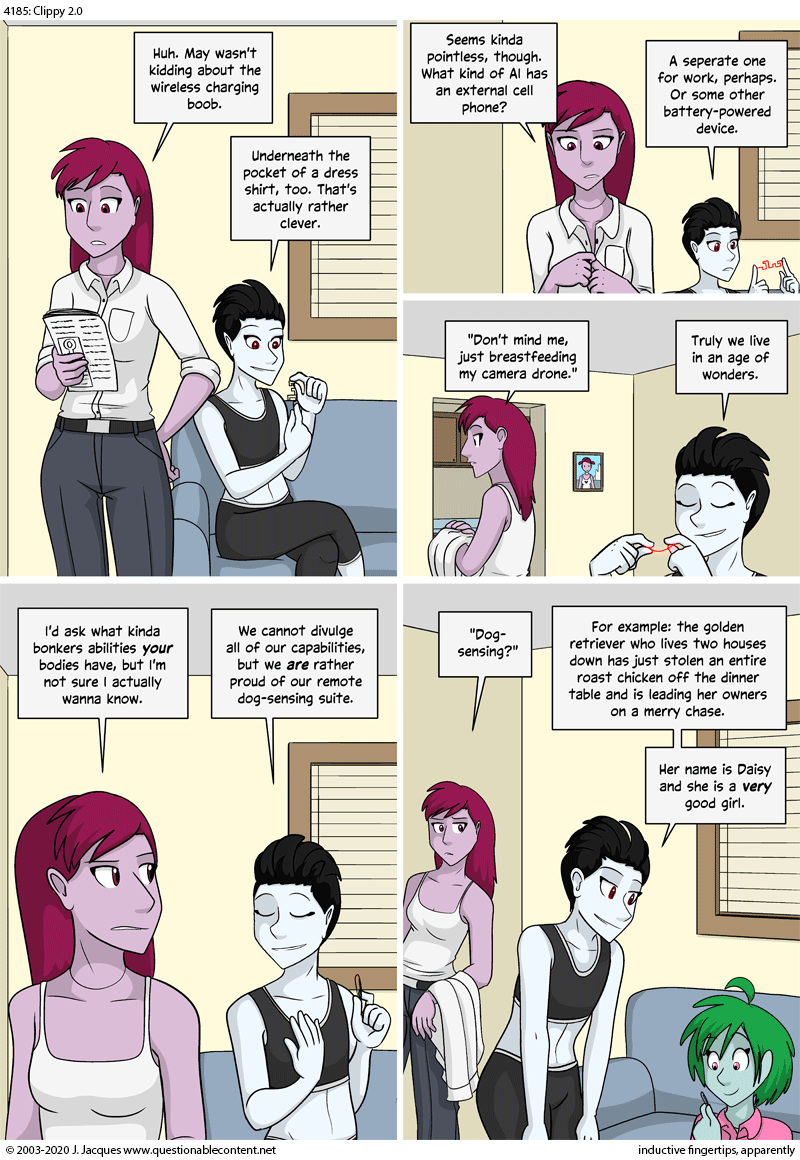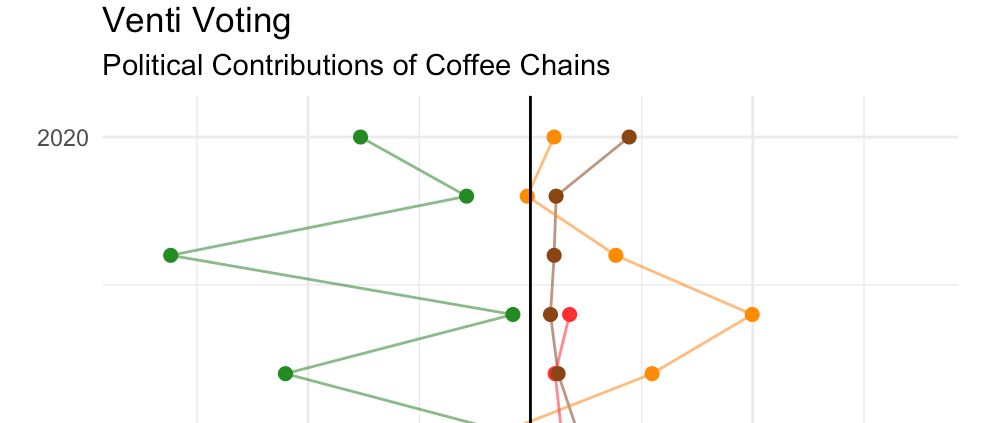Bramble Park Zoo in Watertown South Dakota received an early Christmas gift. A baby yak was born! This is the first for the 108-year-old AZA accredited zoo. In the early morning hours of December 15, zookeepers spotted something on the ground in the domestic yak exhibit. Staff acted quickly and discovered a baby yak had recently been born. The newborn yak needed immediate attention because the mother (3-year-old Nika) was not caring for her new offspring. Zookeepers rounded up towels and blankets and began the process of drying and warming the calf. The calf was treated by the veterinarian for frostbite on the nose and lips, given IV fluids, and a shot of Nuflor to combat possible pneumonia. Zookeepers have been working around the clock to make sure Roberta Dolores is drinking, gaining weight, staying warm, and getting stronger each day. She is drinking 37 oz. of milk replacer each feeding and now weighs 64 pounds. Berta, as the keepers call her, often gets the zoomies when out exercising in the kangaroo yard.
Leahgates
Shared posts
Rabbit Introduction
Leahgatesisn't this how we got starlings or something

COVID Risk Comfort Zone
Leahgatesit's about balance

The Hidden Cost of Your New Wardrobe
LeahgatesDope undergrad project
More than ever, people desire to buy more clothes. Pushed by advertising, we look for novelty and variety, amassing personal wardrobes unimaginable in times past. With the advent of fast fashion, brands like H&M and ZARA are able to provide low prices by cutting costs where consumers can’t see—textile workers are maltreated, and our environment suffers.
In this film, I wanted to play with the idea of fast fashion advertising and turn it on its head. I edited two different H&M look books to show what really goes into the garments they advertise and the fast fashion industry as a whole. I made this film for my Introduction to Sociology class after being inspired by a reading we did earlier in the semester.
Robert Reich’s (2007) book, Supercapitalism, discusses how we have “two minds,” one as a consumer/investor and another as a citizen. He explains that as a consumer, we want to spend as little money as possible while finding the best deals—shopping at stores like H&M. On the other hand, our “citizen mind” wants workers to be treated fairly and our environment to be protected. This film highlights fast fashion as an example of Reich’s premise of the conflict between our two minds—a conflict that is all too prevalent in our modern world with giant brands like Walmart and Amazon taking over consumer markets. I hope that by thinking about the fast fashion industry with a sociological mindset, we can see past the bargain prices and address what really goes on behind the scenes.
Graham Nielsen is a Swedish student studying an interdisciplinary concentration titled “Theory and Practice: Digital Media and Society” at Hamilton college. He’s interested in advertising, marketing, video editing, fashion, as well as film and television culture and video editing.
Read More:
Links to the original look books: Men Women
Kant, R. (2012) “Textile dyeing industry an environmental hazard.” Natural Science, 4, 22-26. doi: 10.4236/ns.2012.41004.
Annamma J., J. F. Sherry Jr, A. Venkatesh, J. Wang & R. Chan (2012) “Fast Fashion, Sustainability, and the Ethical Appeal of Luxury Brands.” Fashion Theory, 16:3, 273-295, DOI: 10.2752/175174112X13340749707123
Aspers, P., and F. Godart (2013) “Sociology of Fashion: Order and Change.” Annual Review of Sociology 39:1, 171-192
Racism & Hate Crimes in a Pandemic
Despite calls to physically distance, we are still seeing reports of racially motivated hate crimes in the media. Across the United States, anti-Asian discrimination is rearing its ugly head as people point fingers to blame the global pandemic on a distinct group rather than come to terms with underfunded healthcare systems and poorly-prepared governments.
Governments play a role in creating this rhetoric. Blaming racialized others for major societal problems is a feature of populist governments. One example is Donald Trump’s use of the phrase “Chinese virus” to describe COVID-19. Stirring up racialized resentment is a political tactic used to divert responsibility from the state by blaming racialized members of the community for a global virus. Anti-hate groups are increasingly concerned that the deliberate dehumanization of Asian populations by the President may also fuel hate as extremist groups take this opportunity to create social division.

Unfortunately, this is not new and it is not limited to the United States. During the SARS outbreak there were similar instances of institutional racism inherent in Canadian political and social structures as Chinese, Southeast and East Asian Canadians felt isolated at work, in hospitals, and even on public transportation. As of late May in Vancouver British Columbia Canada, there have been 29 cases of anti-Asian hate crimes.
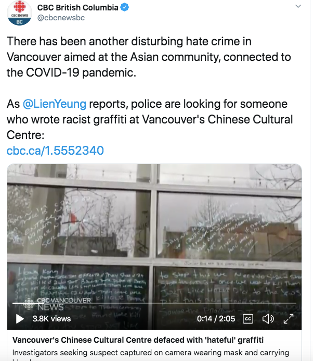
In this crisis, it is easier for governments to use racialized people as scapegoats than to admit decisions to defund and underfund vital social and healthcare resources. By stoking racist sentiments already entrenched in the Global North, the Trump administration shifts the focus from the harm their policies will inevitably cause, such their willingness to cut funding for the CDC and NIH.
Sociological research shows how these tactics become more widespread as politicians use social media to communicate directly with citizens. creating instantaneous polarizing content. Research has also shown an association between hate crimes in the United States and anti-Muslim rhetoric expressed by Trump as early as 2015. Racist sentiments expressed by politicians have a major impact on the attitudes of the general population, because they excuse and even promote blame toward racialized people, while absolving blame from governments that have failed to act on social issues.
Kayla Preston is an incoming PhD student in the department of sociology at the University of Toronto. Her research centers on right-wing extremism and deradicalization.
Hair Growth Rate
LeahgatesI found this intensely stressful and I don't know why
maybe because we can't get haircuts?

Second Mexico monarch butterfly activist found dead
LeahgatesThe murder of climate and conservation activists in Latin America is an epidemic we have never really full acknowledged: https://www.globalwitness.org/en/campaigns/environmental-activists/enemies-state/
These bird species are new to science
Leahgatesnew birb alerts
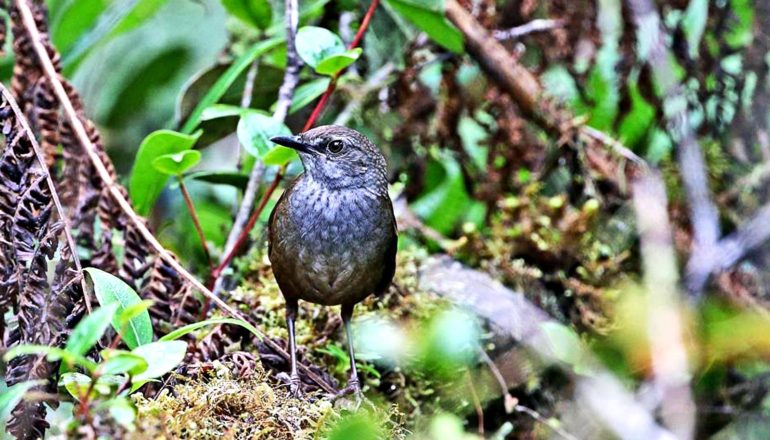
Scientists have discovered five bird species and five subspecies of birds completely new to science in three small island groups off Sulawesi, Indonesia.
Birds are the best known class of animals, and since 1999, scientists have only described five or six new species each year on average.
The team found the birds on islands in the Wallacea region, an archipelago at the interface between the Indomalaya and Australasian biogeographical realms, named after Sir Alfred Wallace, the most famous historical collector exploring the area.
The findings in Science provide evidence that our understanding of species diversity of complex areas such as Wallacea remains incomplete even for relatively well-known groups such as birds, researchers say. They also suggest that modern exploration to find undescribed species diversity can target areas of high promise.
Exploring the interior
Sea depth is an important and long-neglected factor in determining the distinctness of an island’s terrestrial communities. The Earth undergoes periods of glacial-interglacial cycles, leading to the formation of land bridges between shallow islands during ice ages, allowing fauna of the different islands to interbreed.
Deep sea islands, always isolated, and high elevation islands are more likely to harbor endemism due to absence of land connections even during glacial cycles.
Using this knowledge as a guide, Frank Rheindt, an associate professor at National University of Singapore Biological Sciences, and his team concentrated their research efforts on the islands of Taliabu and Peleng, located off the northeastern coast of Sulawesi, as bathymetric data indicate the presence of deep sea between these islands and Sulawesi.
The research team also examined the accounts of historic collectors such as Sir Alfred Wallace, and sought to focus on parts of Wallacea that had received the least coverage by historic collectors, as these areas would hold the highest promise of harboring undescribed avian diversity.
This kind of incomplete historic overage characterized the islands the team targeted. Eight historic collecting expeditions only briefly visited Taliabu and its neighbors, which together form the Sula group. All of the expeditions remained in coastal areas and failed to penetrate the highlands of the interior because of poor accessibility; and only three historic collectors (who never ventured far uphill into the interior) visited Peleng and the remaining islands of the Banggai group.
This many new bird species is a ‘rarity’
For the new study, Rheindt and his team conducted extensive fieldwork on the three remote islands for six weeks, from November 2013 to January 2014, and collected 10 new, long-overlooked avian forms.
By integrating genomic and phenotypic research methodologies, the team successfully described five new songbird species and five new subspecies:
- On Taliabu, they found three new species, the Taliabu Grasshopper-Warbler, the Taliabu Myzomela, and the Taliabu Leaf-Warbler; as well as three subspecies: the Taliabu Snowy-browed Flycatcher, Taliabu Island Thrush, and Sula Mountain Leaftoiler.
- On Peleng, they found two new species, the Peleng Fantail and the Peleng Leaf-Warbler; and a new subspecies: the Banggai Mountain Leaftoiler.
- On Togian, they found a new subspecies, the Togian Jungle-Flycatcher.
“Studying the routes and operations of historic collecting expeditions and identifying gaps has been a fruitful approach to pinpoint focal areas in our case. The description of this many bird species from such a geographically limited area is a rarity,” Rheindt says.
“Going forward, the use of Earth-history and bathymetric information could also be applied to other terrestrial organisms and regions beyond the Indonesian Archipelago to identify promising islands that potentially harbor new taxa to be uncovered.”
During the expedition, the research team found that both Taliabu and Peleng have suffered from rampant forest destruction. There is virtually no primary lowland forest on both islands, and some form of logging or forest fires have affected most highland forests.
“While most of the avifauna we described seems to tolerate some form of habitat degradation and is readily detected in secondary forest and edge, some species or subspecies are doubtless threatened by the immense levels of habitat loss on these islands,” Rheindt says.
“As such, urgent, long-lasting conservation action is needed for some of the new forms to survive longer than a couple of decades beyond their date of description.”
Source: National University of Singapore
The post These bird species are new to science appeared first on Futurity.
Insecticides have gotten way more toxic to honey bees
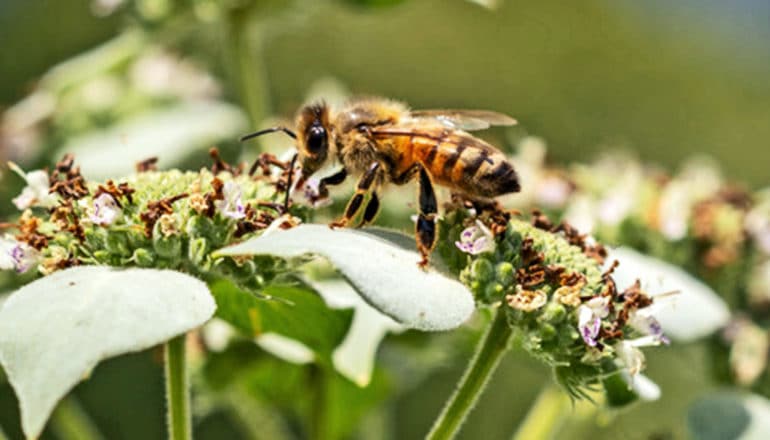
Insecticides have become significantly more toxic—over 120-fold in some Midwestern states—to honey bees when ingested, according to a new study.
Rising neonicotinoid seed treatments applied to corn and soy in US agricultural landscapes during the past 20 years are the primary driver of the change, the researchers found.
The study is the first to characterize the geographic patterns of insecticide toxicity to bees and reveal specific areas of the country where experts could focus mitigation and conservation efforts.
This toxicity has increased during the same period in which researchers have documented widespread decline in populations of pollinators and other insects, says Christina Grozinger, professor of entomology and director of the Center for Pollinator Research at Penn State.
“Insecticides are important for managing insects that damage crops, but they can also affect other insect species, such as bees and other pollinators, in the surrounding landscape,” she says. “It is problematic that there is such a dramatic increase in the total insecticide toxicity at a time when there is also so much concern about declines in populations of pollinating insects, which also play a very critical role in agricultural production.”

‘Heartland’ honey bees
For the study in Scientific Reports, researchers integrated several public databases—including insecticide use data from the US Geological Survey, toxicity data from the Environmental Protection Agency, and crop acreage data from the US Department of Agriculture—to generate county-level annual estimates of honey bee “toxic load” for insecticides applied between 1997 and 2012. The team defined toxic load as the number of lethal doses to bees from all insecticides applied to cropland in each county.
The researchers generated separate estimates for contact-based toxic loads, such as when a honey bee faces a direct spray, and oral-based toxic loads, such as when a bee ingests the pollen or nectar of a recently treated plant. They generated a map of predicted insecticide toxic load at the county level.
The team found that the pounds of insecticides applied decreased in most counties from 1997 to 2012, while contact-based bee toxic load remained relatively steady.
In contrast, oral-based bee toxic load increased by nine-fold, on average, across the US. This pattern varied by region, with the greatest increase—121-fold—seen in the heartland, which the US Department of Agriculture defines as all of Iowa, Illinois, and Indiana; most of Missouri; and part of Minnesota, Ohio, Kentucky, Nebraska, and South Dakota.
The Northern Great Plains had the second highest increase at 53-fold. This region includes all of North Dakota and part of South Dakota, Nebraska, Colorado, Wyoming, Montana, and Minnesota.
“This dramatic increase in oral-based toxic load is connected to a shift toward widespread use of neonicotinoid insecticides, which are unusually toxic to bees when they are ingested,” Douglas says.
Bee toxic load
The most widely used family of insecticides in the world, neonicotinoids are commonly used as seed coatings in crops, such as corn and soybean. Growing plants take up some of the insecticide and distribute it throughout their tissues, while the rest is lost to the environment.
“Several studies have shown that these seed treatments have negligible benefits for most crops in most regions,” says Grozinger. “Unfortunately, growers often don’t have the option to purchase seeds without these treatments; they don’t have choices in how to manage their crops.”
The researchers suggest that the common method of evaluating insecticide-use trends in terms of pounds of insecticides applied does not give an accurate picture of environmental impact.
“The indicator we use—bee toxic load—can be considered as an alternative indicator in cases where impacts to bees and other nontarget insects is a concern,” Douglas says. “This is particularly relevant given that many states have recently developed ‘Pollinator Protection Plans’ to monitor and address pollinator declines. Ultimately, our work helps to identify geographic areas where in-depth risk assessment and insecticide mitigation and conservation efforts could be focused.”
“It is important to note that the calculation of bee toxic load provides information about the total toxicity of insecticides applied to a landscape,” Grozinger says. “It does not calculate how much of that insecticide actually comes in contact with bees, or how long the insecticide lasts before it is broken down. Future studies are needed to determine how toxic load associates with changes in populations of bees and other insects.”
This research is part of a larger project to investigate the various stressors affecting pollinator populations across the US. One tool researchers created within this research project is Beescape, which allows users to explore the stressors affecting bees in their own communities.
Additional coauthors are from Penn State, Dickinson College, and the University of Minnesota.
The National Science Foundation, the US Department of Agriculture’s National Institute of Food and Agriculture’s Agriculture and Food Research Initiative, the Foundation for Food and Agricultural Research, and the US Department of Agriculture’s Economic Research Service funded the work.
Source: Penn State
The post Insecticides have gotten way more toxic to honey bees appeared first on Futurity.
2 doses of flu vaccine for kids cuts hospitalizations in half

Fully vaccinating children reduces the risk of hospitalization associated with influenza by 54%, a new study shows.
In Israel, as in the United States, government guidelines recommend that children 8 or younger who have never received a vaccination, or who have only received one dose of flu vaccine, should receive two doses of vaccine.
Children vaccinated according to government guidelines have much better protection from influenza than those who only receive one vaccine, says Hannah Segaloff, a research fellow at the University of Michigan School of Public Health and lead author of the study in Clinical Infectious Disease.
“Over half of our study population had underlying conditions that may put them at high risk for severe influenza-related complications, so preventing influenza in this group is critically important,” she says.
“Our results also showed that the vaccine was effective in three different seasons with different circulating viruses, reinforcing the importance of getting an influenza vaccine every year no matter what virus is circulating.”
The retrospective study used data from Clalit Health Services, the largest health fund in Israel, to review the vaccination data of 3,746 hospitalizations of children 6 months to 8 years old at six hospitals in Israel. Researchers tested children for influenza over three winter seasons: 2015-16, 2016-17, and 2017-18.
Not only do the findings reveal that the flu vaccine reduced hospitalizations associated with the flu by 54%, but they show that giving two vaccine doses to children up to age 8 who have never received a flu vaccine or only received one dose previously works more effectively than administering one dose, in accordance with the Israel Ministry of Health’s recommendations.
“Young children are at high risk of hospitalization due to influenza complications,” says coauthor Mark Katz, a senior researcher at the Clalit Research Institute, the research arm of Clalit Health Services, and an adjunct associate clinical professor at the Ben Gurion University School of Public Health and Medical School for International Health.
“Children with underlying illnesses such as asthma and heart disease have an even greater risk of getting the complications. It is important to prevent influenza infections in these populations.”
The findings support health organizations’ recommendations, including the Israel Ministry of Health to vaccinate children against influenza every year, preferably before the onset of winter or early childhood. Children under 5 have a high risk of influenza complications.
“This study mirrors a previous study we conducted at Clalit Institute where we found that flu vaccine reduces 40% risk of hospitalizations in pregnant women,” says Ran Balicer, director of the Clalit Research Institute and professor at the BGU School of Public Health.
“It reaffirms that vaccination is the most effective way to prevent both the flu and hospitalization. We hope parents will be aware of these facts and make an informed decision about the importance of vaccinating their children.”
Source: University of Michigan
The post 2 doses of flu vaccine for kids cuts hospitalizations in half appeared first on Futurity.
Care for opioid use disorder is scarce in these states

Treatment for opioid problems is especially scarce in US states with Medicaid work requirements, a new study suggests.
Medicaid work requirements allow states to drop people from their Medicaid health insurance rolls unless they can show that they’re working, in school, have a disability, or are medically frail or receiving treatment for substance use disorder.
The study also shows that states with Medicaid work requirements also have higher rates of opioid overdose deaths than other states—suggesting a need for increased overdose prevention efforts.
In the new paper, researchers examined data from states that have sought or received federal government permission for Medicaid work requirements, and compared it with data from states that haven’t.
The researchers found that work requirement states tend to have fewer substance use disorder treatment facilities that offer care for opioid use disorder. They also have fewer health care providers certified to prescribe the medication buprenorphine, one of the most effective opioid addiction treatments.
The researchers say their findings support a call for more access to substance use disorder treatment, and specifically to evidence-based opioid use disorder care, across the country.
The stakes for patients are higher in work requirement states, however, because of the challenges to employment for people with these conditions and the potential for people to lose their Medicaid health coverage if they can’t find a provider to diagnose or treat their substance use disorder.
Some states with work requirements apply their policy to all Medicaid enrollees, others only to the population the Medicaid expansion program covers.
Starting in 2018, the Centers for Medicare and Medicaid Services invited states to apply for waivers to the Medicaid statute that would allow changes to their programs designed to increase employment and community engagement by enrollees.
Seventeen states have applied, and nine have received approval, though most of them have put their programs on hold because of a federal court case contesting the legal basis of the work requirement waiver.
All of the 17 states except Alabama allow Medicaid participants to count substance use disorder treatment as a form of community engagement to fulfill their work requirement and keep their coverage, or get an exemption from the requirement if they have a formal substance use disorder diagnosis.
“Work requirement states are largely treating substance use disorder as a disability, but many want evidence of a diagnosis, or proof that they’re taking part in an approved treatment program,” says Paul Christine, the internal medicine resident at the University of Michigan who led the analysis of data from several national databases to conduct the study.
“If they’re requiring this as a condition of eligibility, then it’s important to know if treatment resources will be available. And it appears that work requirement states have lower addiction treatment availability, especially in states that have approved waivers.”
Renuka Tipirneni, an assistant professor of internal medicine who worked with Christine on the study, has also studied the effects of Medicaid coverage on enrollees’ mental and physical health, and ability to work.
“We know that gaining coverage is associated with better health and ability to be a productive part of society, and that losing coverage can have the opposite effect,” she says. “States should increase the availability for substance use disorder treatment, and potentially account for the availability of this care when making decisions about Medicaid eligibility and enrollment.”
The prevalence of substance use disorder was similar across states with and without Medicaid work requirements. But states with approved Medicaid work requirement waivers had a higher incidence of both overall overdose-related deaths and opioid-related overdose deaths, compared with states with pending or no work requirements
Increasing the availability of medication-based therapy for opioid use disorder is a priority nationwide, the researchers say. In states with Medicaid work requirements, failing to do so may have health and health insurance repercussions for individuals with substance use disorders.
The paper appears in the Journal of General Internal Medicine.
Support for the research came in part from the University of Michigan and the National Institutes of Health.
Source: University of Michigan
The post Care for opioid use disorder is scarce in these states appeared first on Futurity.
‘Perfect droughts’ hit California water sources 6 times a century
Leahgatestree data (trata)

Severe droughts have happened simultaneously in the regions that supply water to Southern California almost six times per century on average since 1500, according to new research.
The study is the first to document the duration and frequency of simultaneous droughts in Southern California’s main water sources—the Sacramento River basin, the Upper Colorado River Basin, and local Southern California basins.
The report highlights what a previous researcher dubbed “perfect droughts”—when precipitation or streamflow in all three water sources falls below the median for two or more years. The most recent perfect drought lasted from 2012 to 2015.
Concurrent droughts lasting multiple years in all three sources of water for Southern California pose “the most serious challenge to water management,” the authors write in the Journal of American Water Resources Association.

Researchers used the annual growth rings of trees to reconstruct the climate history of the three water sources back to the year 1126. For the period 1906 to 2017, instruments recorded the amount of annual precipitation and streamflow.
“Such a reconstruction of the water supply for Southern California has not been done before,” says first author Connie Woodhouse, a professor in the School of Geography and Development at the University of Arizona.
5-6 perfect droughts every 100 years
The California Department of Water Resources (CADWR) wanted to know the past frequency and duration of severe droughts in the major sources of Southern California’s water supply and funded the study.
The team found perfect droughts were not unusual and were evenly distributed in time since about 1400, with about five to six such droughts per 100 years, Woodhouse says. More severe and longer-term droughts occurred during the warmer 11th and 12th centuries.
“California Department of Water Resources has a long history as a water resources department of using paleodata to help its understanding of drought,” says coauthor David Meko, a research professor of dendrochronology in the Laboratory of Tree-Ring Research.
The researchers also tested whether specific oceanic or atmospheric circulation patterns could be linked to the occurrence of perfect droughts. The only pattern they found was that perfect droughts coincided with high pressure off the northwest Pacific Coast that pushes storm tracks north of all three sources of water.
Woodhouse and Meko previously studied droughts in the Sacramento River Basin and the Colorado River Basin for CADWR using tree rings to reconstruct streamflow patterns back to the 10th century or earlier. The agency asked the team to expand on previous studies to include water sources in Southern California.
Tree ring records
Each annual growth ring of a tree reflects the growing conditions, including temperature and precipitation, during that year. By taking either pencil-thin cores from living trees or cross-sections of dead trees, scientists piece together the patterns of annual rings to reveal growing conditions going back centuries. The climate information in tree rings also reflects variations in streamflow, making it possible to develop reconstructions of past streamflow.
Groundwater is one of the water sources for Southern California. There are not enough historical instrumental records of groundwater records to develop a reconstruction going back centuries, so the team used precipitation as a proxy for groundwater.
To determine past precipitation for Southern California going back 890 years, Erica Bigio, a member of the research team while at the University of Arizona and now a lecturer at the University of Nevada, Reno, led the team in collecting additional tree-ring records from mountain ranges including the San Bernardino, San Gabriel, and San Jacinto mountains.
The team also checked whether perfect droughts coincided with specific atmospheric or oceanic conditions, which was a new approach, Meko says.
“The California Department of Water Resources wanted this long-term information to help with planning,” he says. “The broader question is what causes these simultaneous droughts in these different basins.”
The researchers found that no one atmospheric or oceanic circulation pattern, such as El Niño, corresponded with severe droughts in all three basins.
The team did find that perfect droughts occurred in Southern California when the storm tracks shifted north. Several different atmospheric circulation patterns can cause that shift.
Longer and more severe droughts in all three basins occurred in the 11th and 12th centuries, a time period when the climate was warmer, Woodhouse says. “We had a nine-year perfect drought and a seven-year perfect drought—and they were pretty much West-wide.”
Given the projected changes in water availability due to warming, “perfect droughts such as 2012-2015 may become increasingly common, with the potential for even longer events to occur,” the researchers conclude.
Source: University of Arizona
The post ‘Perfect droughts’ hit California water sources 6 times a century appeared first on Futurity.
Neighbors’ solar panels can shift climate change beliefs

New research details what happens to climate change bias when people witness their neighbors putting solar panels on their roofs.
“Any new laws or advancements in technologies and movements to curb climate change require substantial political and public support. Public perception is crucially important since the public is far more skeptical about climate change than the scientific community,” says coauthor Andrea La Nauze, assistant professor in the economics department at the University of Pittsburgh.
The study, which analyzed five years of survey data collected between 2010 and 2014 in Australian communities, showed that for every additional 1,000 solar panels in a neighborhood, the share of neighbors that believe human action primarily causes climate change increased by seven percentage points.
“They see their neighbors install solar panels, so they get interested and read more on them and climate change to update their beliefs. Maybe they receive government funding to install panels, or maybe they just believe their neighbors more than scientists. There’s all kinds of possibilities as to why,” says Graham Beattie, assistant professor of economics at Loyola Marymount University, who worked on the study as a postdoctoral researcher at the University of Pittsburgh until 2018.
As a follow up to this research, La Nauze is writing a working paper explaining the spillover effects from solar panels to other people’s actions regarding climate change.
On the flip side, the research team also found that the addition of 1,000 solar panels caused concern about the effects of climate change to fall by six percentage points.
“They believe something large enough is being done to tackle this problem,” says La Nauze. “We’re not able to say what the mechanism behind that is, but it is something we’re trying to understand more.”
While a golden rule in science is that correlation doesn’t mean causation, the researchers argue that the study’s model determines a causal relationship.
“One thing we’re able to do with a technique called instrumental variables is argue that this relationship is causal; if you install solar panels in a neighborhood, it has a direct effect on people’s beliefs. This is new in literature,” La Nauze says. “The economic return to solar panels shouldn’t have a direct effect on people’s belief in climate change, but it does have a direct effect on solar panel uptake.”
La Nauze studies environmental and energy economics. With the US government funding about $154 billion between 1993 and 2018 to study climate change, La Nauze says it’s important for the general public to be informed about these study results.
According to a 2019 Pew Research study, while 59% of Americans believe that global climate change is a “major threat,” 41% say it’s a “minor threat” or not a threat at all.
“It is in our economic interests to be undertaking mitigation. We have science that tells us this is a problem, and we have economic models that tell us climate change is also an economic problem,” La Nauze says. “We’re trying to figure out the optimal allocation of resources. Our Earth’s atmosphere is a resource and it can be argued right now that we’re not allocating that resource optimally.”
“There’s a lot more solar installation in Australia than there is in the US, but conjecturally speaking, there’s no reason why this relationship wouldn’t also exist in the US,” Beattie adds.
The research appears in Environmental and Resource Economics.
Funding for the study came from a seed grant from the University of Pittsburgh’s Mascaro Center for Sustainable Innovation.
Source: University of Pittsburgh
The post Neighbors’ solar panels can shift climate change beliefs appeared first on Futurity.
How aquifer recharge water can get contaminated with arsenic

The potable water municipalities use to recharge an aquifer can become contaminated with dangerous levels of arsenic, new research shows.
To replenish groundwater, many municipalities inject reclaimed water into depleted aquifers. Secondary wastewater treatment has purified the injected water, and, in some cases, the water has been treated through tertiary processes and can be clean enough to drink directly.
The original water in the aquifer was chemically stable, in equilibrium with the surrounding rocks, and natural processes (water infiltration) had slowly recharged it. However, when people consume more groundwater than the natural processes can restore, engineered recharging with purified, reclaimed water is necessary. Unfortunately, over time, the reclaimed water sometimes becomes contaminated.
In a managed aquifer recharge, “we continuously draw down the aquifer, but we never refill it enough,” says Young-Shin Jun, professor of energy, environmental, and chemical engineering at the McKelvey School of Engineering at Washington University in St. Louis.
“Our population can grow quickly and our lifestyle becomes more water dependent but the natural refilling process is slow,” she says. ” So water management practice has engineered a way to inject water to compensate for our consumption and achieve environmental sustainability.”
Keeping aquifers full is important for a few reasons. On the coasts, salty seawater can fill a depleted aquifer, creating a disastrous situation for the ecosystem and crops that the aquifer feeds. And, if the depleted zone remains empty, sinkholes can occur and the land may subside. Thus, refilling aquifers to provide drinking water is a standard practice in places from California to Florida.
But about 10 years ago, when working on managed aquifer recharge with the Environmental Protection Agency (EPA), Jun encountered a puzzling situation.
“When we injected the water, it was good,” she says, “but when we withdrew it, it was bad, tainted with arsenic. What was wrong?”
It turned out that although the water being injected into the aquifer was usually clean enough to drink, it was bringing something new to the aquifer: oxygen.
“By injecting reclaimed water, we are triggering oxidative dissolution of sulfide minerals in the aquifer, which were stable at low oxygen levels,” she says. In particular, she looked at arsenopyrite (FeAsS), a mineral that dissolves into iron, sulfur, and, crucially, arsenic. Before the arsenic can reach problematic levels, however, another reaction takes place.
“The iron precipitates into iron oxides or hydroxides,” Jun says. The arsenic adsorbs, or adheres, to the iron oxides or hydroxides, which are insoluble, keeping arsenic out of the water.
There is, however, another important factor.
Dissolved organic matter (DOM)—compounds that contain carbon—changes the situation drastically. “With high levels of organic compounds, we found the precipitation reaction is suppressed,” Jun says. When precipitation of iron oxides or hydroxides is suppressed, the arsenic does not adsorb sufficiently. Instead, it remains available in the water.
Jun is quick to emphasize that this is more than an experimental exercise in laboratory exercise. “This is not a potential future problem,” she says, noting that using reclaimed water is actual practice right now.
“When thinking about water reclamation from aquifers, we need to consider the roles of organic matter,” Jun says.
“We have to take into account the DOMs in injected water to make sure they do not trigger more mobilization of toxins,” Jun says. “The roles of DOMs in managed aquifer recharge should be included in the predictive models. Knowing how water chemistry alters the chemical reactions in an aquifer will enable us to fully utilize the water, rather than discarding it as waste.
“Please keep in mind that there is only one kind of water in the world,” she says.
“All water—drinking water, seawater, groundwater, wastewater, stormwater, greywater, and more—is simply ‘water.’ Keeping it safe and sustainable is our continuing homework.”
Support for the work came from the National Science Foundation, and the US Department of Energy, Office of Science, Office of Basic Energy Sciences.
The research was published in Environmental Science and Technology.
Source: Washington University in St. Louis
The post How aquifer recharge water can get contaminated with arsenic appeared first on Futurity.
Venti Voting?
I just wrapped up my political sociology class for the semester. We spent a lot of time talking about conflict and polarization, reading research on why people avoid politics, the spread of political outrage, and why exactly liberals drink lattes. When we become polarized, small choices in culture and consumption—even just a cup of coffee—can become signals for political identities.
After the liberals and lattes piece, one of my students wrote a reflection memo and mentioned a previous instructor telling them which brand of coffee to drink if they wanted to support a certain political party. This caught my attention, because (at least in the student’s recollection) the instructor was completely wrong. This led to a great discussion about corporate political donations, especially how frequent contributions often go bipartisan.
But where does your money go when you buy your morning coffee? Thanks to open-access data on political contributions, we can look at the partisan lean of the top four largest coffee chains in the United States.
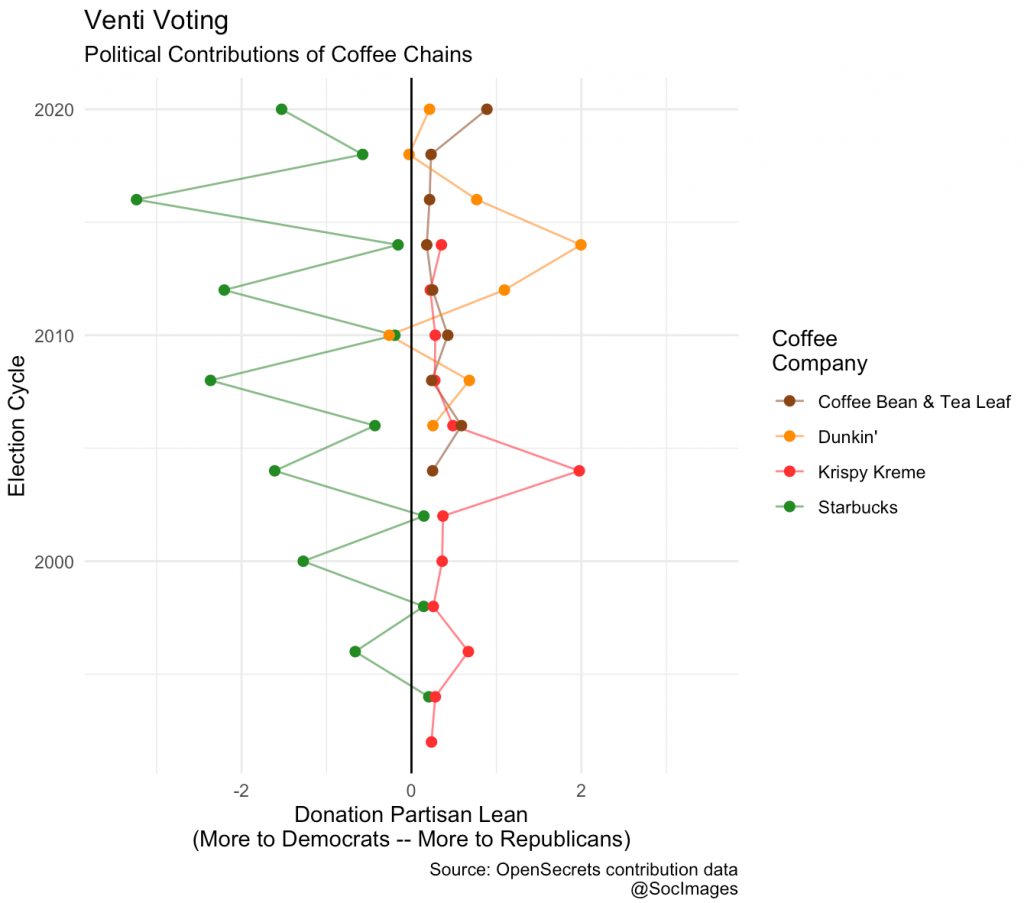
Starbucks’ swing to the left is notable here, as is the rightward spike in Dunkin’s donations in the 2014 midterms. While these patterns tend to follow the standard corporate image for each, it is important to remember that even chains that lean one way still mix their donations. In midterm years like 2012 and 2014, about 20% of Starbucks’ donations went to Republicans.
One side effect of political polarization is that corporate politics don’t always follow cultural codes. For another good recent example of this, see Chick-fil-A reconsidering its donation policies.
Evan Stewart is an assistant professor of sociology at University of Massachusetts Boston. You can follow him on Twitter.(View original at https://thesocietypages.org/socimages)
Political events take an emotional toll on young doctors

Some political events affected the moods of first-year doctors who started their careers in the past few years just as much as the strenuous first weeks of their training had, researchers report.
The results come from a real-time, long-term assessment of the moods of young doctors, called interns, in relation to major political and non-political events of the past few years.
Major American political events of the last three years altered the interns’ moods, but non-political events didn’t, signaling a politically aware generation of physicians.
The authors call for further exploration of the interactions between politics and medicine, and the implications for physicians and their patients.
The study used data from an ongoing study of intern health that has already yielded findings about the high risk of depression among interns, and the relationship between intense stress and mental health in general.
The new paper focuses on daily mood ratings from 2,345 interns who were in their first year of training at American hospitals anytime between mid-2016 and late 2018, and how they changed in the immediate aftermath of major national and world events.
The largest collective changes in mood followed three events—the 2016 US election, the 2017 US presidential inauguration, and the failure of a federal spending bill to fund a Mexican border wall.
The first of these events was actually associated with a drop in mood larger than the drop that interns experienced in the first weeks of their intense training. The second led to a sizable mood drop, while the third led to a collective mood boost.
The authors note in an accompanying commentary that the decline in mood immediately after the election was four times greater than any other day they had tracked, and female interns’ mood drop was twice as large as that seen among male interns. The study group was 55% female, a slightly higher percentage than the current generation of recent medical school graduates.
Two-thirds of the major political events in the study period prompted significant changes in interns’ moods. No nonpolitical event during the study period—not mass shootings, hurricanes, wildfires, a royal wedding, or a solar eclipse—affected interns’ moods.
“This suggests to us that interns were deeply engaged with and affected by the election, even while facing the incredible demands of their intern year,” says Elena Frank, the director of the Intern Health Study. “It also suggests that the 2016 election was experienced as deeply personal and distressing for many young women in medicine.”
Srijan Sen, the principal investigator of the Intern Health Study and a professor in the psychiatry department at the University of Michigan, says that given the intensity of the intern year’s demands, he had been surprised that any external event managed to affect the moods of interns as much as the study shows.
He recalls that Hurricane Katrina decimated New Orleans and neighboring areas of the Gulf Coast during his own intern year, and he only became aware weeks later.
“The new generation of physicians seems to be more politically engaged than how doctors had traditionally been seen,” he says. “This suggests that there is a real opportunity for physicians to lend their voice and join the discussion on issues relevant to clinicians and their patients.”
The researchers used mood ratings collected daily from interns via a smartphone app used in the study, which asks them to assess their mood each evening. They combined these data with national Google search data about the most searched-for events during the study period.
They note that the strong negative and positive reactions to certain news events may also have to do with the changing demographics of those going into the medical profession—not just more women, but more people of color, and more people from varied socioeconomic backgrounds.
But the question of whether the broader range of backgrounds—and political views—of doctors will translate into more political activism and public expression of views still remains to be seen. Physicians in the past may have refrained from engaging in politics in public ways, to avoid having their political views affect their interactions with patients.
“There has always been a vigorous debate in medicine on whether physicians should engage in politics and to what extent,” says coauthor Brahmajee Nallamothu, professor of internal medicine at the University of Michigan. “These data suggest deep engagement is happening in young doctors during even their most intense clinical workload.”
The new findings may also add to understanding how the tumult of the current period may be affecting people who aren’t in the midst of intense medical training.
“Political events may be affecting people’s moods in ways they didn’t before, and we hope our research in general can help illuminate the ways that stress and external events affect mental health,” says Sen.
The paper appears in BMJ.
Source: University of Michigan
The post Political events take an emotional toll on young doctors appeared first on Futurity.
Exoplanets with magma oceans may ‘eat’ their own skies
Leahgatesextremely metal

A new study suggests a reason why exoplanets rarely grow larger than Neptune: the planets’ magma oceans begin to eat their skies.
In 2014, NASA’s Kepler Space Telescope handed scientists a smorgasbord of more than 700 brand-new distant planets to study—many of them unlike what anyone had previously seen. Instead of gas giants like Jupiter, which earlier surveys had picked up first because they are easier to see, these planets were smaller and mostly rock by mass.
Scientists noticed that there were lots of these planets about the size of or just larger than Earth, but there was a steep cutoff before planets reached the size of Neptune.
“This is a cliff edge in the data, and it’s quite dramatic,” says Edwin Kite, an assistant professor in the geophysical sciences department at the University of Chicago. “What we have been puzzling over is why planets would tend to stop growing beyond about three times Earth’s size.”
The researchers offer an innovative explanation for this drop-off: The oceans of magma on the surface of these planets readily absorb their atmospheres once planets reach about three times the size of Earth.
Exoplanet mystery
Kite, who studies the history of Mars and the climates of other worlds, was well-positioned to study the question. He thought the answer might hinge on a little-studied aspect of such exoplanets. Most of the planets slightly smaller than the drop-off size are thought to have oceans of magma on their surfaces—great seas of molten rock like the ones that once covered Earth. But instead of solidifying as ours did, these are kept hot by a thick blanket of hydrogen-rich atmosphere.
“Nothing like these worlds exists in our solar system…”
“So far, almost all models we have ignore this magma, treating it as chemically inert, but liquid rock is almost as runny as water and very reactive,” says Kite.
The question Kite and his colleagues considered was whether, as the planets acquired more hydrogen, the ocean might begin to “eat” the sky. In this scenario, as the planet acquires more gas, it piles up in the atmosphere, and the pressure at the bottom where the atmosphere meets the magma starts to build. At first, the magma takes up the added gas at a steady rate, but as the pressure rises, the hydrogen starts to dissolve much more readily into the magma.
“Not only that, but the little bit of the added gas that stays in the atmosphere raises the atmospheric pressure, and thus an even greater fraction of later-arriving gas will dissolve into the magma,” Kite says.
Thus the planet’s growth stalls out before it reaches the size of Neptune. (Because the majority of the volume of these planets is in the atmosphere, shrinking the atmosphere shrinks the planets.)
The authors call this the “fugacity crisis,” after the term that measures how much more readily a gas dissolves into a mixture than what would be expected based on pressure.
Looking ahead
The theory fits well with existing observations, Kite says. There are also several markers that astronomers could look for in future. For example, if the theory is correct, planets with magma oceans that are cold enough to have crystallized on the surface should display different profiles, since this would prevent the ocean from absorbing so much hydrogen.
Ongoing and future surveys from TESS and other telescopes should give astronomers more data with which to work.
“Nothing like these worlds exists in our solar system,” says Kite. “Although our work suggests a solution to one of the puzzles posed by sub-Neptune exoplanets, they still have a lot to teach us!”
The research appears in Astrophysical Journal Letters.
Funding for the work came from NASA, NSF, Penn State, Eberly College of Science, Pennsylvania Space Grant Consortium, Washington University, and Stanford University.
Source: University of Chicago
The post Exoplanets with magma oceans may ‘eat’ their own skies appeared first on Futurity.
Proton therapy for cancer cuts radiation side effects

Proton therapy for cancer patients significantly lowers risk of side effects so severe they can lead to unplanned hospitalizations when compared with traditional radiation, a new study shows.
Further, cure rates between the two groups are almost identical.
The findings come from an expanded analysis of the largest review of its kind designed to evaluate whether or not patients undergoing radiation therapy at the same time as chemotherapy experience serious adverse events within 90 days.
As reported in JAMA Oncology, researchers found proton therapy reduces the relative risk of these side effects by two-thirds.
“This is exciting because it shows that proton therapy offers a way for us to reduce the serious side effects of chemo-radiation and improve patient health and well-being without sacrificing the effectiveness of the therapy,” says lead author Brian Baumann, an adjunct assistant professor of radiation oncology at the University of Pennsylvania and assistant professor of radiation oncology at Washington University School of Medicine in St. Louis.
Proton therapy vs. photon radiation
Proton therapy has a few key differences from traditional photon radiation. Photon radiation typically uses multiple x-ray beams to deliver radiation to the tumor target but unavoidably deposits radiation in the normal tissues beyond the target, potentially damaging those tissues as the beam exits the body.
Proton therapy is an FDA-approved alternative radiation treatment that directs positively charged protons at the tumor. They deposit the bulk of the radiation dose to the target with almost no residual radiation delivered beyond the target, reducing damage to surrounding healthy tissue and potentially reducing side effects.
“We know from our clinical experience that proton therapy can have this benefit, but even we did not expect the effect to be this sizable.”
For this study, researchers evaluated side effects including pain or difficulty swallowing, difficulty breathing, nausea, or diarrhea, among others. Focusing on grade-three effects or higher, defined as side effects severe enough for patients to require hospitalization, the researchers evaluated data on 1,483 cancer patients receiving radiation and chemotherapy at the same time.
Of these, 391 patients received proton therapy, while 1,092 underwent photon treatment. All patients had non-metastatic cancer and were undergoing treatment intended to be curative. The study included patients with brain cancer, head and neck cancer, lung cancer, gastrointestinal cancer, and gynecologic cancer treated with concurrent chemo-radiation.
The primary outcome was whether or not patients experienced adverse side effects that were grade-three or higher within 90 days of treatment. In the proton group, only 11.5% of patients (45) did, compared to 27.6% of patients (301) in the photon group. A weighted analysis of both patient groups, which controlled for other factors that may have led to differences between the patient groups, found that the relative risk of a severe toxicity was two-thirds lower for proton patients compared to photon patients.
“We know from our clinical experience that proton therapy can have this benefit, but even we did not expect the effect to be this sizable,” says senior author James Metz, chair of radiation oncology, leader of the Roberts Proton Therapy Center, and a member of Penn’s Abramson Cancer Center.
Better for older patients
Importantly, overall survival and disease-free survival were similar between the two groups, suggesting that the reduction in toxicity seen with proton therapy did not come at the cost of reduced effectiveness.
Researchers say these results hint at the promise of proton therapy as a way to deliver intensified systemic therapy and/or higher dose radiation therapy more safely, which could improve survival outcomes. In fact, data showed that while older patients with more comorbidities were more likely to receive proton therapy, they experienced fewer side effects.
“This tells us proton therapy may allow older patients to receive the most effective combined treatments, and that older, sicker patients can more safely be included in clinical trials that use proton therapy,” Baumann says.
While researchers say they need to do further research, they point out that the study offers the best information so far as randomized controlled trials continue to prove difficult to complete.
Source: University of Pennsylvania
The post Proton therapy for cancer cuts radiation side effects appeared first on Futurity.
The Cherry On Top
Leahgateskeep trying buddy

I'll be running some bonus strips funded by my Patreon supporters through New Year's day, then regular comics will resume. Happy holidays!
Meet Olaf, the IVF Toad
Leahgateshecc
You aren’t going to see this guy on the big screen any time soon, but he and others just like him may end up in their native habitat very soon. This tiny toad is the world’s first Puerto Rican crested toad hatched from in-vitro fertilization (IVF) utilizing frozen semen collected from the wild.
The Fort Worth Zoo and its partners from Mississippi State University came together at the Fort Worth Zoo this summer to continue their efforts with assisted reproduction technology (ART) for critically endangered amphibians. For the first time ever, they were able to successfully conduct IVF using the eggs from two Zoo females and frozen semen from six wild males. To celebrate this conservation success, the first egg to be fertilized and hatched has been named Olaf! (Yep, just like that Olaf.)
This is a significant advancement for the critically endangered species as it will allow zoos, researchers and other conservationists to expand their population genetics used to increase the overall population while keeping the toads in their wild, natural habitat. These ART efforts will help maintain a genetically diverse, self-sustaining population of toads in the managed population without removing animals from the wild!
Since 2006, Zoo staff has coordinated and managed a Puerto Rican Crested Toad conservation program, under the direction of Fort Worth Zoo Curator of Ectotherms Diane Barber. Through this cooperative program, thousands of Puerto Rican crested toad tadpoles are released into the wild each year. As the longest continuous reintroduction program for any amphibian species, the Puerto Rican crested toad project has released over 510,000 tadpoles at six reintroduction sites since 1992 – the Fort Worth Zoo alone has released 70,988 of those tadpoles.
What’s Trending? Towns Getting “Tanked”
LeahgatesSpoiler alert: it's racism
Modern policing is often characterized by quasi-militaristic tendencies, from “wars” on drugs and crime to its use armored vehicles and automatic weapons. The Department of Defense 1033 Program, which provides military equipment slated for storage to law enforcement agencies, is a popular way that police and sheriff’s departments acquire military gear. According to data from the Defense Logistics Agency, acquisitions of military equipment by state and local law enforcement sharply rose to a peak in 2016, and then have declined in recent years. But what explains participation in the DOD’s program? Which police departments acquire the most military equipment?
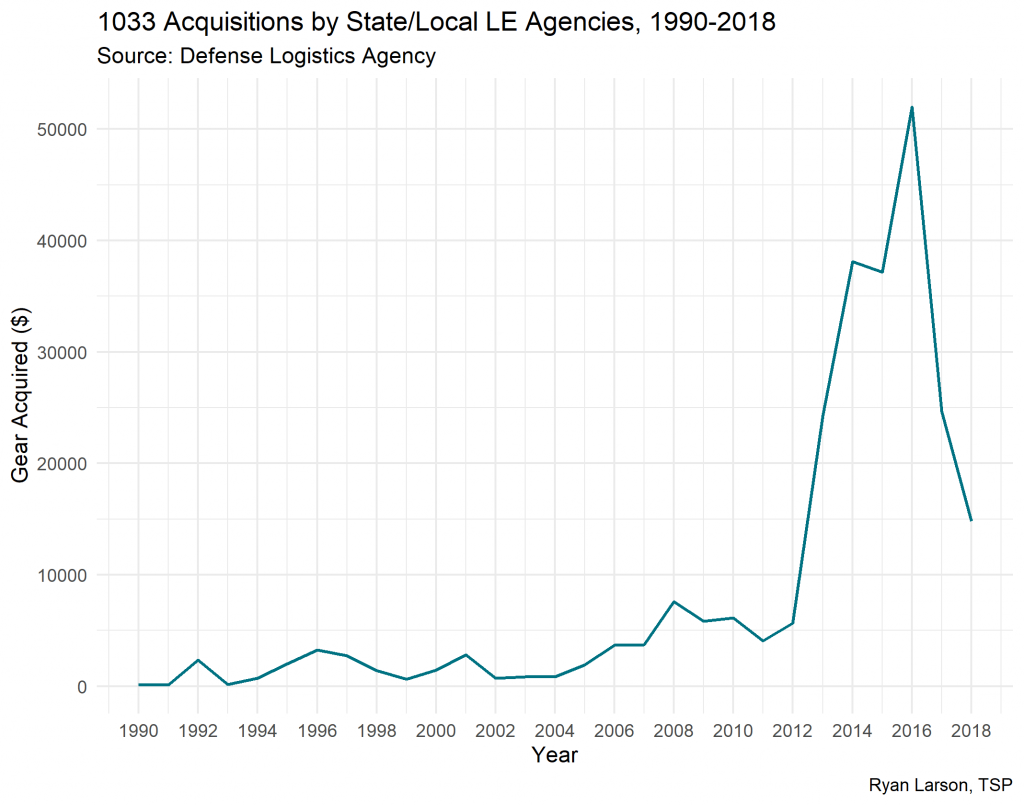
In a recent study published in Criminology, David Ramey and Trent Steidley investigate whether law enforcement agencies participated in the program and how much gear they acquired using 1033 program participation and U.S. Census and American Community Survey data. They find that participation in the 1033 — but not the value of gear acquired — is greater in areas of higher violent arrests. They also find that, after controlling for crime rates and other factors, higher local Black and Hispanic populations correlate with higher levels of participation and greater value acquired.
However, these racial patterns are not linear. Agencies operating in areas with very small and very large minority populations have low probabilities of program participation, but agencies that serve a more diverse community are most likely to obtain military equipment through the 1033 program. For those that do participate, increases in minority populations correlated with higher dollar values of equipment acquired, with each subsequent increase garnering even more gear than the last (an exponential increase). In other words, program participation increases in response to racial demographics up to an extent, but once an agency decides to participate, the value of military equipment requested dramatically increases as minority populations increase.
Trends in police militarization highlight two patterns. Law enforcement agencies respond to increasing crime rates with police militarization, possibly in an attempt to deter further crime. In contrast, the racial effects found in this study follow a “minority threat” model, as military acquisitions correspond to the presence of racial minority groups. This research illustrates how race, net of the crime rates in an area, can pattern not only where police operate, but how they operate.
Ryan Larson is a graduate student from the Department of Sociology, University of Minnesota – Twin Cities. He studies crime, punishment, and quantitative methodology. He is a member of the Graduate Editorial Board of The Society Pages.
(View original at https://thesocietypages.org/socimages)
Meet Keti, An Adorable Baby Red Panda
Over the years, Detroit Zoo officials have had the pleasure of caring for a number of adorable babies, but in the opinion of Dr. Ann Duncan, director of Animal Health at DZG, their current nursery resident – a female red panda cub – is arguably the most adorable animal in Detroit Zoo history. She was born July 6, and weighed 112 grams (around 4 ounces), a good weight for a red panda cub. While the cub’s mother Ash was pregnant, she allowed officials to ultrasound her abdomen while she happily ate treats, so they knew she was pregnant with a single cub that was growing well. Ash delivered the baby with no problems, and showed the newborn lots of attention, but this was her first pregnancy, and she didn’t have all of the skills needed to raise the cub. Red panda cubs have been hand-reared at several zoos, including the Detroit Zoo, and they had prepared in advance to care for the panda cub, just in case. A hand-rearing manual that compiles collective experiences of zoo professionals was used to determine the formula and feeding schedule and help to develop a care plan.
Endangered baby pangolin takes his first steps after rescue from poachers
A rescued young Sunda pangolin takes his first tentative steps after being released back into the wild in Thailand, in a series of photographs snapped by staff from international conservation charity ZSL (Zoological Society of London).
The Critically Endangered animal was being illegally kept in cramped conditions and constant darkness by a poacher, before being saved by ZSL staff and local park rangers.
Nicknamed Kosin – inspired by the Thai name for the god Indra, celebrated as a friend to humanity - by his rescuers, the puppy-sized youngster, estimated to be under a year old, weighed just 1kg and measured 67-centimetres nose-to-tail.
Believed to have been snatched at night by poachers searching for pangolins to sell, experts think Kosin was kept alive as the meat and scales of live pangolins reach a higher price on the black market than those of dead animals.
Following his rescue, Kosin was given a thorough health check and despite his ordeal found to be in good condition. After a short period of monitoring he was ready to be returned to the wild.
The team from ZSL transported him to a remote, safe place as far away from known poaching hotspots as possible and have been monitoring his release site ever since. They are pleased to report that no poachers have been seen there since his release, giving Kosin the best possible chance of survival.
Dr Eileen Larney, ZSL Conservationist said: “It was an extraordinary moment to watch Kosin being released back into the wild and then take his first steps back to the wild, but sadly his story is rare. Our team was able to get to him in time, care for him and return him to the wild. Thanks to the support of our donors and our incredible team he has been given a precious second chance, something many thousands of his species do not get.
“A single pangolin is worth up to three months’ wages for rural villagers in Thailand and is considered as valuable as a lottery win.
“However, to combat the illegal pangolin trade we must stop poaching at the source. It’s a complex puzzle which requires global collaboration to both reduce demand and increase protection. This story would have had a very different ending without the quick response of park rangers and ZSL’s conservation partners. Like all pangolins, Kosin faces an uncertain future but in moments like this we have hope.”
All eight species of pangolin are now threatened with extinction due to widespread poaching. Worldwide, pangolins are thought to be the most illegally trafficked mammal. A seizure of pangolin scales in April 2019 weighed 14 tonnes, representing about 36,000 individual animals. Estimates suggest more than 300 pangolins are poached from the wild every day.
ZSL is working in Thailand, Cameroon, Nepal, and the Philippines to protect pangolins and other Endangered species from illegal wildlife trade. The team collaborates with communities to raise awareness, find alternative sources of income and create protected habitats where pangolins can thrive.
Drawing on a hugely successful track record of empowering communities across Asia and Africa. – ZSL will continue to support communities in Nepal helping communities to plan and create environmentally sustainable ways to make a living and build the same opportunities for people in Kenya too – home to rhinos and elephants – through its UK Aid Match appeal - For People. For Wildlife.
The future of wildlife and people are intertwined, and long-term success depends on solutions that work for everyone. Through the UK Aid Match appeal ZSL is working alongside rural communities in Nepal and Kenya to set up sustainable ways to make a living, empowering them to feed their families, build independent futures and protect the wildlife they live alongside.
They’re an odd couple but it works . • • • #bullyinstafeature #englishbulldog_feature #bullypics #theworldofbullies #bul...
A montage of pure happiness with @ziggy_golden_girl and @jojothepawcess . • • • #bullyinstafeature #englishbulldog_feat...
LeahgatesI'm sorry that I'm biologically incapable of not sharing every single montage of this ludicrous potato
Lazy blob didn’t want to go on his late night walk . • • • #bullyinstafeature #englishbulldog_feature #bullypics #thewor...
Leahgatesclickthrough is required



